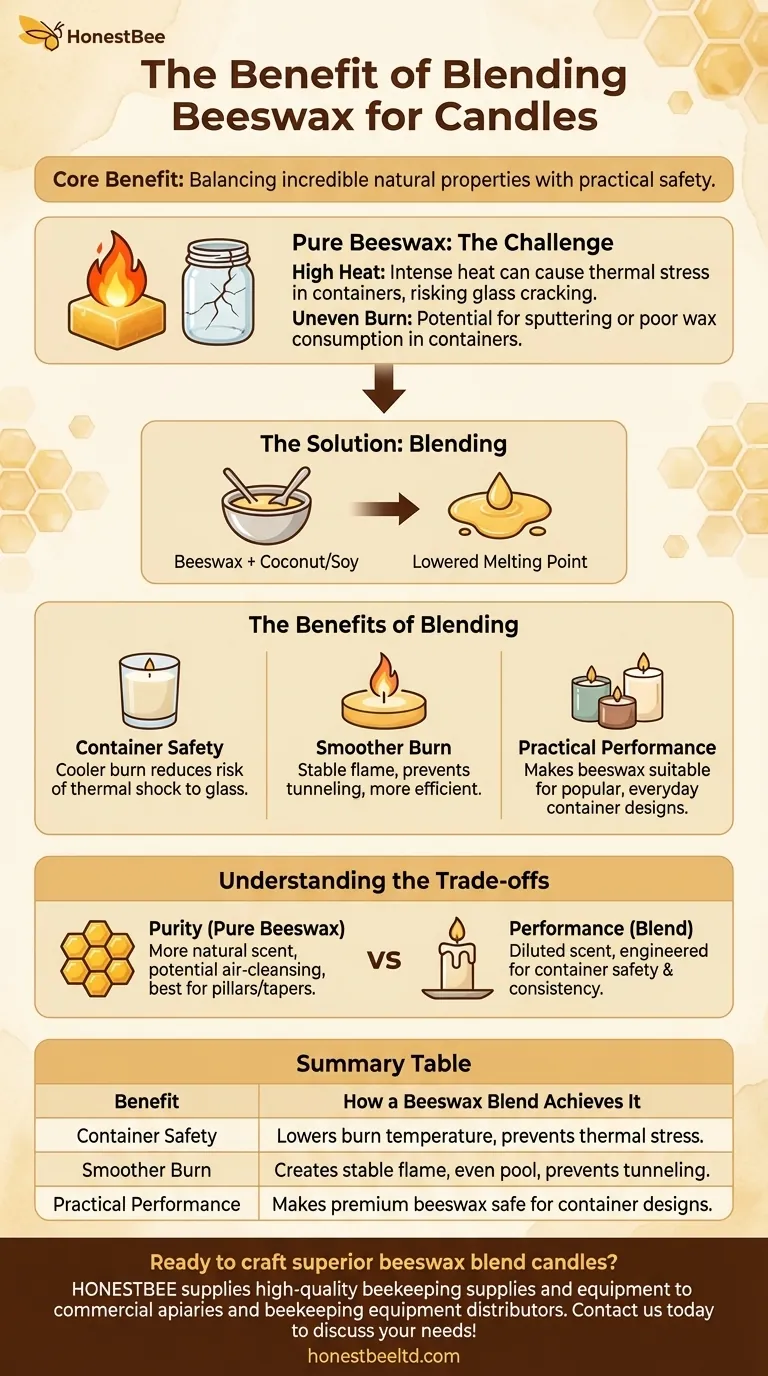The primary benefit of blending beeswax is to moderate its burn characteristics for practical use. By adding another wax or oil, such as coconut or soy, you lower the mixture's overall melting point, which solves the key challenge of pure beeswax: its intense heat can be unsuitable and unsafe for certain types of containers.
The core reason for creating a beeswax blend is to balance its incredible natural properties with practical safety. You are essentially engineering the wax to burn at a lower, safer temperature, making it compatible with standard glass candle containers while aiming for a smoother, more consistent burn.

The Challenge of Pure Beeswax
Pure beeswax is a premium candle material for good reason. It is known for its long, clean burn and the bright, vibrant light it produces. Many also value it for its natural, honey-like scent and purported air-purifying qualities.
However, its high performance comes with a practical challenge.
The Problem of High Heat
Beeswax burns significantly hotter than many other popular waxes. While this contributes to its bright flame, it can create a safety issue.
The intense heat can cause thermal stress in small or standard glass containers, leading to overheating. In the worst-case scenario, this can cause the glass to crack or even shatter.
The Impact on Burn Quality
For a candle to burn well, the wax pool must melt evenly across the container's surface. If the wax gets too hot too quickly, as pure beeswax can, it may not burn as smoothly or efficiently, especially in containers.
Furthermore, any impurities in the wax can clog the wick, and the high heat can exacerbate this issue, leading to a sputtering flame or self-extinguishing wick. Using clean, filtered beeswax is a prerequisite for a good candle, whether pure or blended.
How Blending Solves the Problem
Blending beeswax with a softer wax or oil is a targeted solution to manage its high burn temperature and improve its performance in containers.
Lowering the Melting Point
The most direct benefit of adding coconut oil or soy wax is that it lowers the overall melting point of the wax mixture.
These additives have a much lower melting point than beeswax, and when combined, they create a blend that becomes liquid at a more moderate temperature.
Ensuring Container Safety
A lower melting point translates directly to a cooler burning candle. This reduces the risk of thermal shock to glass containers, making the final product safer for everyday use.
This adjustment is what makes beeswax blends suitable for the popular container candles found on the market.
Achieving a Smoother Burn
A cooler, more controlled melt pool often results in a "smoother" burn. The flame is typically more stable, and the wax is consumed more evenly down the container.
This prevents tunneling (where the wick burns down the center, leaving excess wax on the sides) and creates a more efficient, aesthetically pleasing, and longer-lasting candle.
Understanding the Trade-offs
The decision to blend is a choice between purity and performance in a specific application. While a blend solves the heat problem, you are diluting the 100% beeswax.
This means you are also diluting some of its unique characteristics, such as its natural scent profile and the concentration of its purported air-cleansing properties. A blended candle is a compromise engineered for safety and consistency in containers.
Making the Right Choice for Your Goal
Ultimately, the choice between pure beeswax and a blend depends entirely on the type of candle you want to create.
- If your primary focus is purity and you are making pillar or taper candles: Use 100% pure, clean beeswax, as there is no container at risk of overheating.
- If your primary focus is safety and performance in glass containers: Use a beeswax blend with coconut oil or soy wax to ensure a safer, smoother burn.
Choosing the right wax formulation for your specific purpose is the hallmark of thoughtful candle making.
Summary Table:
| Benefit | How a Beeswax Blend Achieves It |
|---|---|
| Container Safety | Lowers the burn temperature to prevent glass from cracking due to thermal stress. |
| Smoother Burn | Creates a more stable flame and even wax pool, preventing tunneling. |
| Practical Performance | Makes premium beeswax suitable and safe for popular container candle designs. |
Ready to craft superior beeswax blend candles? HONESTBEE supplies high-quality beekeeping supplies and equipment to commercial apiaries and beekeeping equipment distributors. Our wholesale-focused operations ensure you get the reliable materials you need for your candle-making business. Contact us today to discuss your needs and elevate your product line!
Visual Guide

Related Products
- Beeswax Melter for Candle Making Honey Bee Wax Melter
- Professional Stainless Steel Wax Melter for Beekeeping and Crafts
- Steam Beeswax Melter Wax Warmer for Wax Processing
- Professional Frame Preparation: The HONESTBEE Electric Wire Embedder
- 10L Stainless Steel Honey Wax Press Extractor for Wax Cappings
People Also Ask
- What is the best way to melt beeswax for candles? The Safest Method for Professional Results
- What are the primary products of honey bee farming besides honey? Discover the Hive's Hidden Treasures
- What is the flashpoint of beeswax? Essential Safety and Quality Tips for Beekeepers
- What are the benefits of using a professional wax melter? Achieve Consistent, Scalable, and Safe Production
- How does a steam wax melter work? A Fast, Efficient Method for High-Quality Wax


















